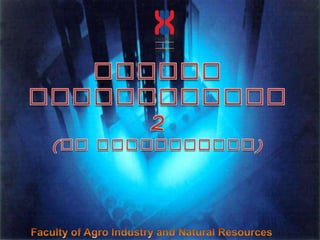
Kuliah geokimia 6a
- 1. Isotop Geochemistry 2 (IG Application) Faculty of Agro Industry and Natural Resources
- 2. Radiometric Dating Actually a simple technique. Only two measurements are needed: The parent:daughter ratio measured with a mass spectrometer. The decay constant measured by a scintillometer
- 3. Lab for extracting parent and daughter elements
- 4. Mass spectrometer to measure ratio of parent and daughter elements.
- 5. Basis of the Technique Radioactive elements “decay.” Decay occurs as an element changes to another element, e.g. uranium to lead. The parent element is radioactive, the daughter element is stable. The decay rate is constant.
- 6. What is Radioactivity? Radioactivity occurs when certain elements literally fall apart. Usually protons and neutrons are emitted by the nucleus. Sometimes an electron is emitted by the nucleus, which changes a neutron to a proton. Sometimes an electron is captured by a neutron replacing a proton.
- 9. A Familiar Example: Carbon-14 Carbon-12 (with 6 protons and 6 neutrons) is the most common isotope of carbon. Carbon-14 is an rarer isotope of carbon that is produced by the bombardment of nitrogen-14 (with 7 protons and 7 neutrons) by rogue neutrons Nitrogen-14 gains 1 neutron but loses 1 proton, changing it to carbon-14 (atomic mass stays the same, but atomic number changes)
- 11. Carbon-14 becomes incorporated into carbon dioxide, along with the more common carbon-12, which circulates in the atmosphere and is absorbed by living things (all organisms, including us, contain a small amount of carbon-14) As long as the organism is alive, the proportions of carbon-12 and carbon-14 remain constant due to constant replacement of any carbon-14 that has decayed
- 12. When the organism dies, the amount of carbon-14 gradually decreases as it decays to nitrogen-14 by the loss of an electron (so one neutron is changed to a proton) By comparing the proportions of carbon-14 and carbon-12 in a sample of organic matter, and knowing the rate of conversion, a radiocarbon date can be determined Number of protons: 6 Number of neutrons: 8 Number of protons: 7 Number of neutrons: 7
- 13. Rate of radioactive decay Rates of decay are commonly expressed in terms of half-life Half life is the time required for half of the atoms in a sample to decay to daughter atoms Half-life of carbon-14 is 5,730 years
- 14. This means: If parent:daughter ratio is 1:1 (1/2 original amount of parent remaining),one half-life has passed If parent:daughter ratio is 1:3 (1/4 original amount of parent remaining), two half-lives have passed If parent:daughter ratio is 1:7 (1/8 original amount of parent remaining), three half-lives have passed If parent:daughter ratio is 1:15 (1/16 original amount of parent remaining),four half-lives have transpired In other words, each half-life represents the “halving” of the preceding amount of parent isotope
- 15. So: If the half-life of carbon-14 is 5730 years If 1/16 of the original amount of parent remains… Then we can deduce that… 4 half lives have passed The age of the sample is 4 X 5730 years = 22, 920 years !
- 17. Other useful radioisotopes In addition to Carbon-14, other radioisotopes can be used for dating (very old samples must rely on radioisotopes with longer half lives). All of the above radioisotopes occur in minerals found in rocks (generally igneous rocks).
- 18. Example: Potassium-Argon 89% of potassium-40 decays to calcium-40 (by electron loss) 11% of potassium-40 decays to argon-40 (by electron gain) Calcium-40 is not useful in dating (can’t be distinguished from other isotopes of calcium that may have been present when the rock formed) But …………. Argon-40 is a gas that doesn’t combine with other elements and becomes trapped in crystals (so amount produced by decay can be measured)
- 19. Datable minerals preserved in: Potassium-argon clock starts when potassium-bearing minerals (e.g. some feldspars) crystallize from a magma The minerals that have crystallized from magma formed will contain potassium-40 but not argon-40 Potassium-40 decays, producing argon-40 within the crystal lattice All daughter atoms of argon-40 come from the decay of potassium-40 Ash deposits Lava flows Igneous intrusions (dykes, sills, plutons) Argon-40, produced by decay of potassium-40 accumulates in mineral crystals
- 20. Igneous rocks, both intrusive and extrusive, come from magma- potassium minerals can be dated To determine age, the potassium-40/argon-40 ratio is measured and the half life of K-40 is applied So now, we have a means of bracketing periods of time in rock sequences, and can apply absolute dates to important events in earth history
- 21. Difficulties in dating the geologic time scale Not all rocks can be dated by radiometric methods Grains comprising clastic sedimentary rocks are not the same age as the rock in which they formed (have been derived from pre-existing rocks) The age of a particular mineral may not necessarily represent the time when the rock formed if daughter products are lost (e.g. during metamorphic heating) To avoid potential problems, only fresh, unweathered rock samples should be used
- 22. Importance of radiometric dating: Rocks from several localities have been dated at more than 3 billion years Confirms the idea that geologic time is immense
- 24. Dating sedimentary strata using radiometric dating Dating of minerals in ash bed and dyke indicates that the sedimentary layers of the Dakota Sandstone through to the Mesaverde Formation are between 160 and 60 million years old
- 25. Always expect the unexpected
